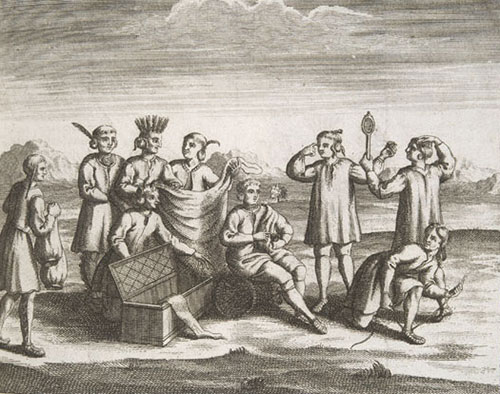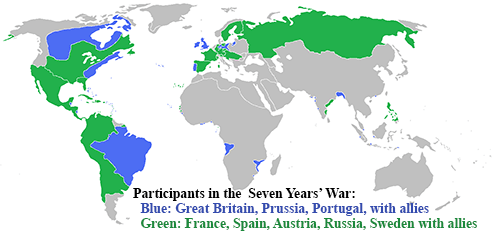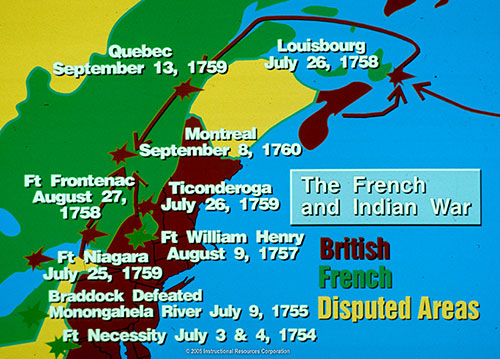Learn
The French and Indian War: 1754-1763
Who fought?
The answer seems obvious – the French fought the Indians, right? Not exactly.... French (with the help of Native Americans) fought the British (with the help of colonists, who were, of course, British citizens) and some Native Americans.
Why?
The war was caused by a rivalry between the French and British, especially over claims to land wanted by both sides that was valuable for fur trading and settlements.
Who won?
The British won the war. If the French had won, we might all speak French instead of English.
Causes of the War
The British and their American colonists waged war against the French and their Native American allies. The war lasted nine years, and they struggled over the control of land in eastern North America, including the Ohio River Valley.
The French had a better relationship with the Native Americans than the British because the French traded with them (for example, trading guns for furs). Instead, the British pushed the Native Americans off their land to develop permanent settlements.

Rivalry Between Britain and France
The English settlers built towns and cleared land for permanent settlements along the eastern seacoast. On the other hand, the French explored farther inland and claimed a vast region stretching from the Appalachians to the Rocky Mountains.

The War Begins
In May 1754, the first battle was fought in Pennsylvania for control of the Ohio River Valley.
At just twenty-one years old, George Washington commanded a small force of British colonists at Fort Necessity. The French far outnumbered the British and the colonists returned home to Virginia defeated and disgraced. Occurring at the beginning of Washington's military career, this was his only surrender ever.


Image is licensed under CC BY-NC-ND 2.0.

The Albany Plan of Union
While Washington was trying to hold Fort Necessity, a group of delegates from seven colonies in the North met in New York in June 1754. These delegates met to develop a plan to become allies with the Iroquois Confederacy– a powerful alliance of Native American tribes in the northeastern part of the present-day United States.
Ben Franklin, a delegate from Pennsylvania, proposed the Albany Plan of Union, which called for a permanent union of the colonies led by a grand council of representatives elected from each colony.

The colonies rejected the Albany Plan of Union because it gave too much power to a central government. However, it provided a model for the future government of the United States.
Early Battles
The British suffered early defeats because they were trained to fight in the open and in straight lines.
General Edward Braddock commanded a force of 1,500 British troops and 450 colonial militia (or armed citizens who serve as soldiers) in July 1755. The Battle of the Monongahela in western Pennsylvania lasted three hours and resulted in huge British casualties. One-third of the British forces were killed (including Braddock) with another third wounded.
George Washington and Daniel Boone the American explorer and frontiersman were among those who survived. Washington also helped save many troops while serving as an aide-de-camp, which restored his reputation as a competent leader after his earlier defeat at Fort Necessity.

Seven Years' War
The fighting in the colonies over land disputes during the French and Indian War eventually spread to Europe in 1756. This global affair is known as the Seven Years' War and it involved many countries.

Image is licensed under CC BY 3.0.
The Tide Turns
In 1756, Great Britain formally declared war on France as fighting spread to Europe (remember, Seven Years' War). Britain's prime minister William Pitt raised taxes to fund the war. Pitt was determined to win, even it if meant expanding the conflict, because he wanted to expand British influence in North America.
In July 1758, the British captured Fort Duquesne from the French and renamed it Fort Pitt.
The Iroquois Confederacy supported the British after the French retreated into Canada. They helped the British capture Fort Ticonderoga and Fort Niagara in 1759. The Iroquois, also known as the Six Nations, fought alongside the British in hopes that they would be grateful and, in return, allow the Native Americans to retain their ancestral lands.
Also in 1759, Quebec fell to the British, commanded by General James Wolfe.
By 1761, the British had seized Fort Detroit and other French posts to end the war.

"Map of Crucial Battles of French and Indian War." Discovery Education, IRC, 2005, app.discoveryeducation.com/learn/player/b1f9e157-32ea-45df-a4eb-a8827298e754.
Treaty of Paris in 1763
The Treaty of Paris, 1763 ended the French and Indian War. It was signed on February 10, 1763. In this agreement:
- England gained control of all French lands in Canada, exclusive rights to Caribbean slave trade, and commercial dominance in India.
- France lost possessions in Canada, most of their empire in India, and claims to lands east of the Mississippi River.
- Spain got all French lands west of the Mississippi River and New Orleans, but lost Florida to England.
Effects of the War
Look at the maps below to see the territorial changes from 1754 to 1763.

"Map of Claims by European Powers Prior to 1754." Discovery Education, IRC, 2005, app.discoveryeducation.com/learn/player/ed3aacfd-b7f1-4c5d-b714-79269df057ca.

"Map, European Claims, North America After 1763." Discovery Education, IRC, 2005, app.discoveryeducation.com/learn/player/9e73f24a-a95e-4056-9eeb-5d4b730ce771.
Additional Resources
Explore the following from USHistory.org to learn more about the French and Indian War: